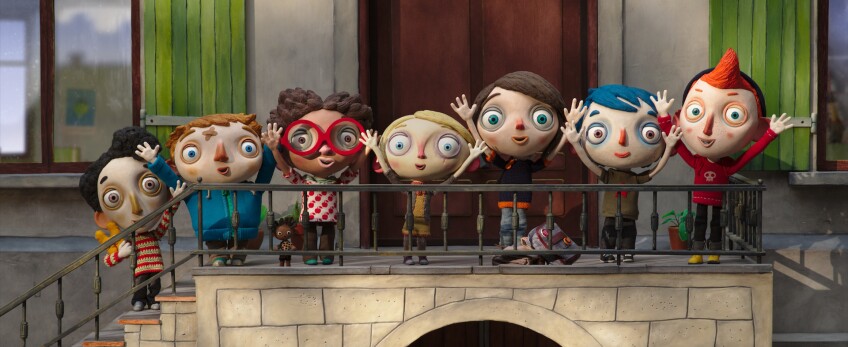Stop-Motion Film 'My Life as a Zucchini' Animates Real-Life Issues


Michel Merkt has produced a lot of films, but he never thought that his career would head into animation. "I always said that I would never do animation," he says. "Never, never, never."
That all changed when Merkt, who is based in Monaco, read the script for an adaptation of Gilles Paris' novel, "Autobiographie d'une Courgette." Now, he's sitting in a West Hollywood hotel room on a stormy afternoon in the midst of the lead-up to the Oscars. He has three films in the running this year, amongst them "Elle," for which Isabelle Huppert is nominated in the best actress category, and foreign language film nominee "Toni Erdmann." And then there's "My Life as a Zucchini," also known as "Ma Vie de Courgette," a Swiss-French stop-motion animation co-production that has been making waves, having already won a Satellite Award. Merkt has notes scribbled onto his palm for a speech he'll be giving the following night.
On a table stands Zucchini, or Courgette, the blue-haired protagonist of the film. This is actually the ninth and final Zucchini puppet made during the course of the film's production and he's dressed up in a formal new outfit for the award show season. Zucchini's head is large, made so that the animators could work easily with him, and his facial expressions are interchangeable. There's a box of mouth shapes on the table. Inside another box is a collection of expressive eyebrows and eyelids. Zucchini is ready for any situation that might arise when the winners are announced.
Merkt's original apprehension towards producing animation was practical; animated films are notoriously difficult to make. But, "My Life as a Zucchini" was different. When he came into the project five years ago — and the film's journey actually began well before that — he knew that it would be something special. In fact, he recalls telling the team, "I'll see you at the Oscars." Now, that's happening, but it took a long time to get to this point.
Merkt relates the intense process of making stop-motion animation to live action. For a live action film, he says, you can shoot anywhere from five to seven minutes of footage in a day. With stop-motion, where every figure has to be posed and re-posed to create an action, directors can expect to get three to four seconds of screen time captured in a work day. When "Zucchini" first went into production, the production crew began work with three to four sets that could be used by each animator on staff. It turned out that they would need much more space just to get the film shot in a reasonable amount of time. Ultimately, they worked 15 sets, which allowed them to shoot about one minute of footage every day.
But, the work began long before that. Back when they were trying to secure financing, the "Zucchini" team had to convince potential investors that this project would do well. That's not particularly easy for a film that doesn't have a specific market. "Zucchini" centers on a young boy who is sent to an orphanage when his mother dies in an accident. It's an animated film and the main characters are children, but it's not necessarily a film just for little kids. As Merkt describes it, the film is intended for both children and adults — "there are many levels of reading for the movie," he says — but that's a little broader than what is expected for film today.
To put together a package to sell the film, they did some preliminary casting and took the results to the financiers. That worked out well, but, the cast ended up being altered after the fact. So much time had passed before production that the original voice of "Zucchini" had aged and, with a changing voice, he could no longer play the role. That problem was rectified by casting the young actor as an older character.
Meanwhile, Merkt notes that director Claude Barras, who makes his feature directorial debut with "Zucchini," spent three years whittling down the cast of book characters to fit a feature film format and designing the characters. "Often, you see people are not spending enough time on the prep and on the script," says Merkt. "That, I think, is the bigger problem today."

Merkt continues, "People are always saying that there are too many movies. I don't agree with that. I would say that there are not enough good ones." He adds that, last year, 50 animated movies were released. That makes it an even bigger challenge for a relatively small animated film (Merkt estimates the film's global budget as about $8 million.) "For us, being here today is already winning," he says.
"My Life as a Zucchini" opened at Cannes last year and made the rounds at festivals, winning awards along the way. When it opened in Switzerland, word-of-mouth helped garner more attention.
Merkt says that the movie appeals to different viewers for different reasons. He notes how two of his own children, one of whom is almost three and another who is a year younger, latch on to different elements of the movie. "Every age can find its own little story inside it," he says.
"I'm a little Zucchini as well. My parents adopted me at three years old and I like to say I chose my parents at three years old," says Merkt. "It's very touching and it's touching for everyone."
"My Life as a Zucchini" screened at the KCET Cinema Series at ArcLight Cinemas Sherman Oaks on February 21 and opens in theaters on February 24. Listen to a Q&A between KCET Cinema Series host Pete Hammond and producer Michel Merkt below.




